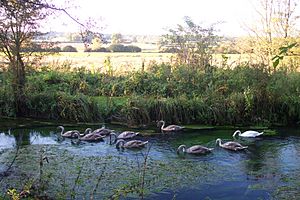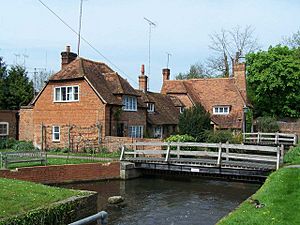River Pang facts for kids
Quick facts for kids Pang |
|
|---|---|

River Pang in Pangbourne
|
|
| Country | England |
| Counties | Berkshire |
| Villages | Farnborough, East Ilsley, Compton, Hampstead Norreys, Frilsham, Bucklebury, Stanford Dingley, Bradfield, Tidmarsh, Pangbourne |
| Physical characteristics | |
| Main source | Varies between Farnborough, Compton and Hampstead Norreys |
| River mouth | River Thames Pangbourne |
| Length | 23 km (14 mi) |
| Discharge (location 2) |
|
| Basin features | |
| Tributaries |
|

The River Pang is a small river in Berkshire, England. It is a special type of river called a chalk stream. It flows for about 23 kilometers (14 miles). The Pang starts near Compton village and joins the big River Thames in Pangbourne village.
Many people believe this river and its water voles inspired the famous author Kenneth Grahame. He wrote the classic book The Wind in the Willows, and the character Ratty might be based on the water voles here!
Contents
Where Does the River Pang Flow?
The River Pang usually starts near the village of Compton. But its exact starting point can change. If there's a lot of rain, it can start further back in Farnborough. If it's very dry, it might start closer to Hampstead Norreys.
From Compton, the Pang flows south through the villages of Hampstead Norreys and Frilsham. Then it turns east. It flows through Bucklebury, Stanford Dingley, and Bradfield.
East of Bradfield, another river called the River Bourne joins the Pang. The Pang then turns north. It flows through Tidmarsh and Pangbourne villages. Finally, it flows into the River Thames. This happens between Whitchurch Lock and Whitchurch Bridge.
The valley where the River Pang flows, between Compton and Bradfield, is quite quiet. Only small country roads go through it. Because it's so peaceful, this area has stayed mostly farmland. It hasn't become a busy place where many people live and travel from for work.
Wildlife in the River Pang
The River Pang is home to lots of amazing wildlife. It's an important part of the local community, especially in Pangbourne. The river has many wild brown trout. These fish can weigh up to about 340 grams (0.75 pounds). You can also find grayling fish here. Finding these fish shows that the river water is generally in good condition.
However, there is a concern in this river. A type of signal crayfish from America has moved in. These American crayfish have pushed out the native white-clawed crayfish species.
The Berks, Bucks and Oxon Wildlife Trust owns a special nature reserve called Moor Copse. This reserve is right next to the Pang, near Tidmarsh village. In 2006, the trust bought more land for the reserve. This new part is about 29 hectares (72 acres). People believe this area might have been where Kenneth Grahame got his ideas for The Wind in the Willows.
In 2007, several big groups worked together. These included the WWF, the National Trust, and the RSPB. They asked the British government to create a plan for water. To show why this plan was important, they talked about famous places from books. These included the Lake District (from Swallows and Amazons), the North Kent Marshes (from Great Expectations), and the River Pang. They wanted to protect these special places.
River Pang Water Quality
The Environment Agency checks the water quality of rivers in England. They give each river an overall "ecological status." This status can be high, good, moderate, poor, or bad. To figure this out, they look at different things. They check the types and amounts of tiny creatures called invertebrates, plants, and fish. They also check the "chemical status." This compares how much of certain chemicals are in the water to safe levels. Chemical status is either good or fail.
In 2019, the water quality of the River Pang was checked. It had a "moderate" ecological status. Its "chemical status" was "fail." This means there are some things that need to be improved to make the river healthier.
What's in a Name?
The River Pang is named after a person. It is thought that an early Saxon leader or a tribe called Pǣga lived near the river long ago. This was after the Roman Empire ended.



